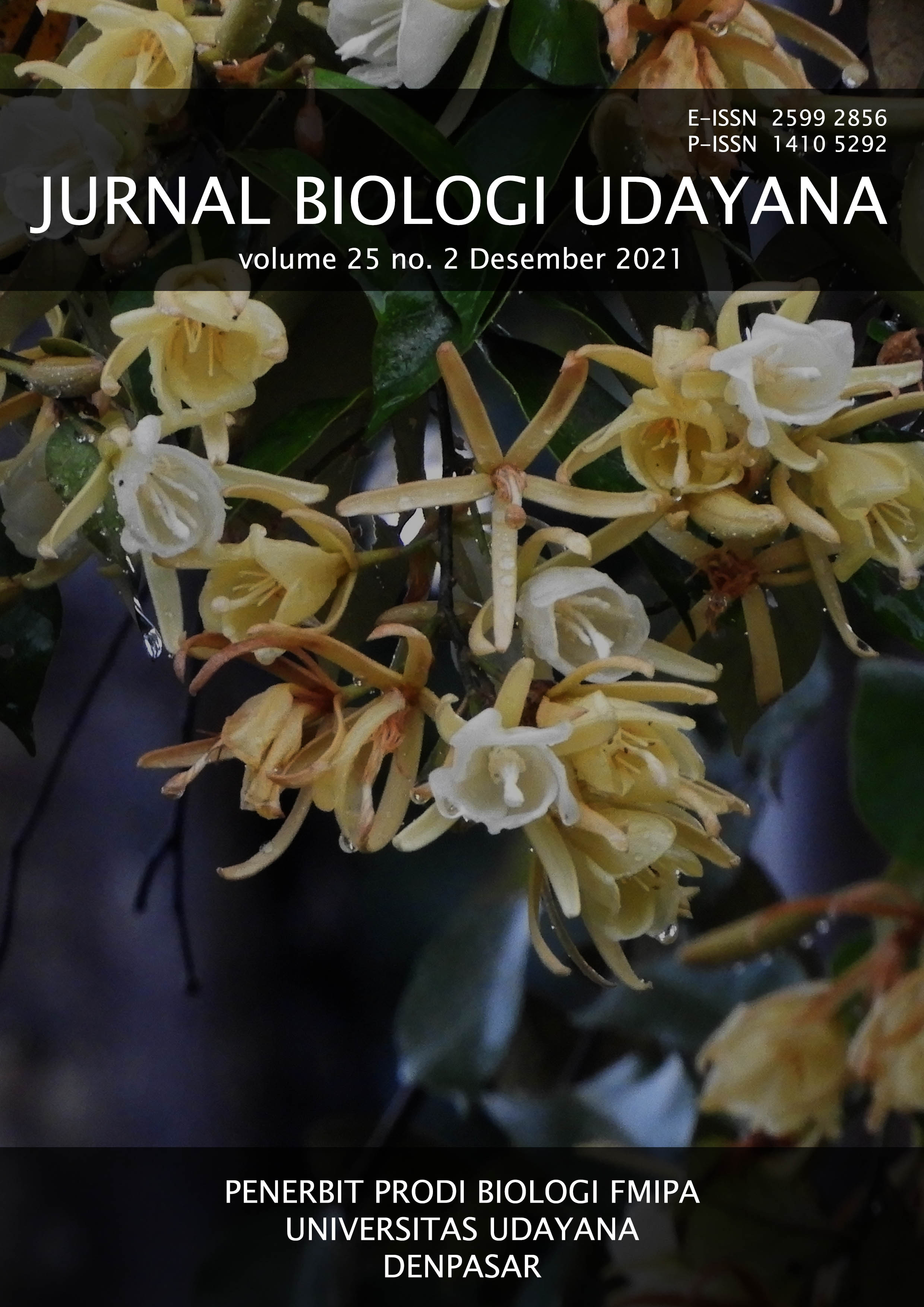Escherichia coli specific bacteriophage isolated from various water sources in Central Bogor, Bogor City as an alternative antibiotic
Abstract
The Research isolated specific phages of Escherichia coli in various water sample in Bogor Tengah, Bogor City and stored them. The Research was conducted in Bogor City in March and April 2020. Phage enrichment was carried out twice as the gold standard method of isolating phages. The plaque test was carried out to confirm the presence of phages in the collected water samples examined using the filtrate obtained only from the phage enrichment method. E. coli isolated in all water samples and phage obtained one water sample, namely the meat dyeing of Pasar Merdeka, Bogor City. The phage concentration in the water sample was 9.1 x 108 PFU/ml. The phage concentration level was considered high enough that it has the potential to be used in the therapy of bacterial infections caused by E. coli.
Downloads
References
Anderson B, Rashid MH, Carter C, Pasternack G, Rajanna C, Revazishvili T, Dean T, Senecal A, Sulakvelidze A. 2011. Enumeration of bacteriophage particles. Bacteriophage 1(2):86-93.doi:10.4161/bact.1.2.15456.
Budiarti S, Rusmana I. 2018. Eksplorasi dan karaterisasi bakteriofag. Bogor (ID): IPB Press. Edisi Pertama.
Chan BK, Abedon ST, Loc-Carrillo C. 2013. Phage cocktails and the future of phage therapy. Future Microbial 8(6):769-783.doi:10.2217/fmb.13.47.
Clokie MR.J, Millard AD, Letarof AV, Heaphy S. 2011. Phages in nature. Bacteriophage 1(1):31-45.doi:10.4161/bact.1.1.14942.
Damayanti R, Jannah SN, Wijanarka, Wijanarka, Rahaju SH. 2016. Isolasi faga Salmonella spp. dari biofilm pada sistem air minum isi ulang. Jurnal Akademika Biologi 5(2):59-67.
Howard-Varona C, Hargreaves KR, Abedon ST, Sullivan MB. 2017. Lysogeny in nature: mechanism, impact, and ecology of temperate phages. The ISME Journal 11:1511-1520.doi:10.1038/ismej.2017.16.
Hyman P. 2019. Phages for phage therapy: isolation, characterization, and host range breadth. Pharmaceuticals 1:12-35.doi:10.3390/ph12010035.
Kartikasari AM, Hamid IS, Purnama MTE, Damayanti R, Fikri F, Praja RN. 2019. Isolasi dan identifikasi bakteri Escherichia coli kontaminan pada daging ayam broiler di rumah potong ayam Kabupaten Lamongan. Jurnal Medik Veteriner 2(1):66-71.doi:10.20473/jmv.vol2.iss1.2019.66-71.
Labrie SJ, Samson JE, Moineau S. 2010. Bacteriophage resistance meschanism. Nature reviews 8:317-326.doi: 10.1038/nrmicro2315.
Lin DM, Koskella B, Lin HC. 2017. Phage therapy: an alternative to antibiotics in the age of multi-drug resistance. World Journal of Gastrointestinal Pharmacology and Therapeutics 8(3):162-173.doi:10.4292/wjgpt.v8.i3.162.
Moons P, Faster D, Aertsen A. 2013. Lysogenic conversion and phage resistance development in phage exposed E. coli biofilms. Viruses 5:150-161.doi:10.3390/v5010150.
Mirzaei MK, Nilsson AS. 2015. Isolastion of phages for phage therapy: a comparison of spot tests and efficiency of plating analysis for determination of host range and efficacy. Plos One 10(3):e0118557.doi:10/1371.journal.pone.0118857.
O’Neill J. 2014. Antimicrobial Resistance: Tackling a crisis for the health and wealth of nations. London: Review on Antimicrobial Resistance. [Internet] Tersedia pada https://amr-review.org/sites/default/files/ AMR%20Review%20Paper%20%20Tackling%20a%20crisis%20for%20the%20health%20and%20wealth%20of%20nations_1.pdf . Diakses pada tanggal 11 November 2018.
Rahaju SH. 2014. Metoda pengkayaan, filtrasi dan pertumbuhan untuk isolasi bateriofag spesifik Salmonella typhimurium pada sampel air. Prosiding Seminar Nasional Penelitian dan PKM: Sains, Teknologi, dan Ilmu Kesehatan, Bandung: 29 Oktober 2014. Vol. 4(1). Hal. 415-422.
Saefunida DS, Wijanarka, Rukmi M.GI, Hidayat NN. 2016. Isolasi bakteriofag Escherichia coli dari sistem distribusi air minum isi ulang sebagai antibiofilm. Jurnal Akademika Biologi 5(2):68-75.
Triana E. 2018. Aktivitas antibiofilm bakteri escherichia coli oleh bakteriofag secara in vitro. Berita Biologi 17(1):77-84.doi:10.14203/beritabiologi.v17i1.3234.
Ulfah NF, Erina, Darniati. 2017. Isolasi dan identifikasi Escherichia coli pada ayam panggang di beberapa rumah makan di Kecamatan Syiah Kuala Kota Banda Aceh. Jurnal Ilmiah Mahasiswa Veteriner 1(3):383-390.
Utami ER. 2012. Antibiotika, resistensi, dan rasionalitas terapi. Sainstis 1(1):124-138.doi:10.18860/elha.v1i4.1783.
[WHO] World Health Organization. 2014. Antimicrobial Resistance: global report on surveillance 2014. WHO.
Yulinery T, Triana E. 2016. Teknik pengkayaan isolasi bakteriofag Salmonella sp. sebagai agen kontrol terapi infeksi bakteri. Prosiding Seminar Nasional II Tahun 2016, Malang: 26 Maret 2016. Hal. 1264-1273.





